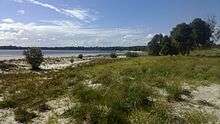Lake Gnangara
Lake Gnangara is the most southerly of the Wanneroo wetlands in metropolitan Perth, Western Australia. The state government's Wetland Atlas defines the body of water as a lake. The surrounding terrain is low dunes and undulating sand plains. The lake is fed by ground water of the Gnangara Mound which is contained by a thin layer of clay.[1]

Previous uses have included diatomaceous earth mining, which may have contributed to changes in the lake's characteristics and ecology. The area is now the subject of a conservation plan and management strategies, and protected from potential disturbance by mining activities.[2]
The Lake reserve is an important part of the management of the mound.[3][4]
The lake surrounds were the site of a long term Nyoongar camp[5] as well as a Nyoongar community college.[6]
Notes
- ↑ Morgan, K. H; Geological Survey of Western Australia (1964), Hydrogeology of the southern part of the Gnangara Lake area : South-West Division, Western Australia, Geological Survey of Western Australia, retrieved 10 March 2012
- ↑ Western Australia. Environmental Protection Authority (1990), Mining diatomaceous earth at Lake Gnangara, Wanneroo, Magic Soil Pty Ltd : report and recommendations of the Environmental Protection Authority, The Authority, ISBN 978-0-7309-3474-5
- ↑ Wanneroo (W.A. : Municipality). Council. (2002) Gnangara Lake Reserve management plan, 2002-2007 City of Wanneroo; [prepared by] ATA Environmental. Wanneroo, W.A.] : City of Wanneroo
- ↑ Bourke, S. A; Western Australia. Dept. of Water (2009), East Wanneroo integrated groundwater-lake flow modelling : predictive scenario modelling to support the Gnangara sustainability strategy, Dept. of Water, ISBN 978-1-921675-13-3
- ↑ Nyoongar Community Aboriginal Corporation records : Lake Gnangara Aboriginal Community, 1970-2008. Battye Library
- ↑ http://slwa.wa.gov.au/pdf/mn/mn3001_3500/mn3014.pdf Nyoongah Community Aboriginal Corporation (NCAC)and Nyoongah Community Incorporated (NCI)Includes Nyoongah Aboriginal Community College established in 1981 to teach Aboriginal children, situated at Lake Gnangara